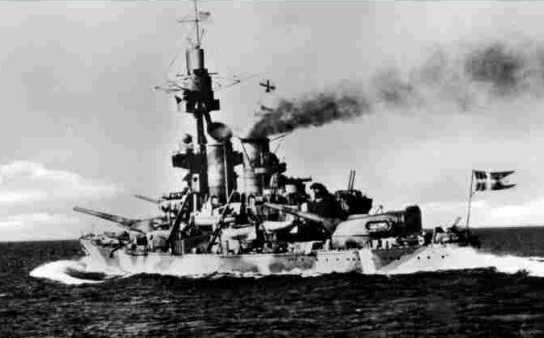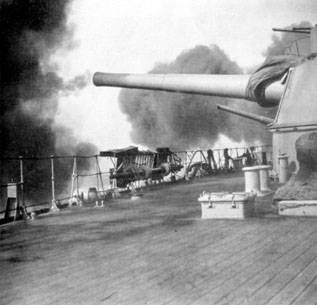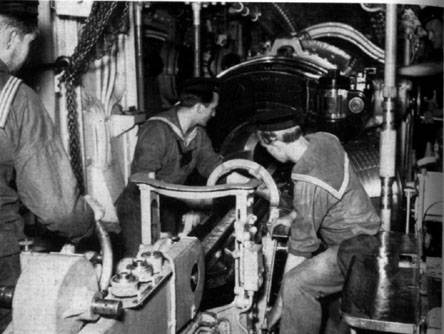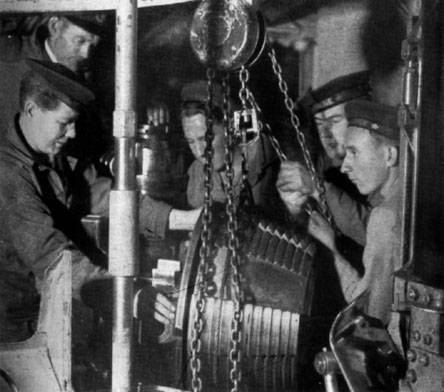A Bofors design, these were used on Sweden's Pansarskepp (Armored Ships) that were active between 1917 and 1947. They were then kept in the reserve fleet until the late 1950s. These guns were of built-up construction with a hand-operated screw breech-block of the Bofors ogival type. They had a high rate of fire and were considered to be quite accurate.
In the 1930s a more aerodynamic "Arrow Nose Shell" was developed which gave an increased range.
One of the guns from Drottning Victoria is now a museum piece at the Karlskrona Naval Base.
| Designation | 28.3 cm/45 (11.1") Model 1912 |
|---|---|
| Ship Class Used On | Sverige Class |
| Date Of Design | 1912 |
| Date In Service | 1917 |
| Gun Weight | 43.4 tons (44.1 mt) |
| Gun Length oa | 501.4 in (12.735 m) |
| Bore Length | about 484.1 in (12.295 m) |
| Rifling Length | 414.0 in (10.515 m) |
| Grooves | 80 |
| Lands | N/A |
| Twist | Increasing RH 1 in 50 to 1 in 28 |
| Chamber Volume | N/A |
| Rate Of Fire | 3 - 4 rounds per minute |
| Type | Bag |
|---|---|
| Projectile Types and Weights | AP: 672.4 lbs. (305 kg) |
| Bursting Charge | N/A |
| Projectile Length | N/A |
| Propellant Charge | 220.5 lbs. (100 kg) |
| Muzzle Velocity | 2,854 fps (870 mps) |
| Working Pressure | 19 tons/in2 (3,000 kg/cm2) |
| Approximate Barrel Life | N/A |
| Ammunition stowage per gun | N/A |
| Elevation | Distance |
|---|---|
| 18 degrees | 21,435 yards (19,600 m) |
| Elevation | Distance |
|---|---|
| 20 degrees | 26,250 yards (24,000 m) |
| 25 degrees | 31,700 yards (29,000 m) |
| Designation | Two-gun Turrets: Sverige (2) |
|---|---|
| Weight | 348.1 tons (353.7 mt) One sources says 406 tons (413 mt) |
| Elevation | As built: -5 / +18 degrees 1 |
| Elevation Rate | 5 degrees per second |
| Train | about +150 / -150 degrees |
| Train Rate | 4 degrees per second |
| Gun recoil | 28.7 in (73 cm) |
| Loading Angle | 0 degrees |
Gun axes were about 83 in (210 cm) apart.
- ^"Naval Weapons of World War Two" says that some reports state that the elevation was increased to 35 degrees. However, Joakim Wohlfeil informs me that the maximum elevation for these guns never exceeded 25 degrees. "Från monitorer till pansarskepp" says that increases were contemplated but never carried out due to financial restrictions and that the elevation may never have exceeded 19 or 20 degrees.
Data from:
- "Naval Weapons of World War Two" by John Campbell
- "Från monitorer till pansarskepp" by Per Insulander and Curt S. Ohlsson
Special help from Stefan Bengtsson, Jeff Brantly, Hans Lineskär and Joakim Wohlfeil
- 06 October 2007
- Benchmark
- 07 February 2016
- Added note about museum gun




